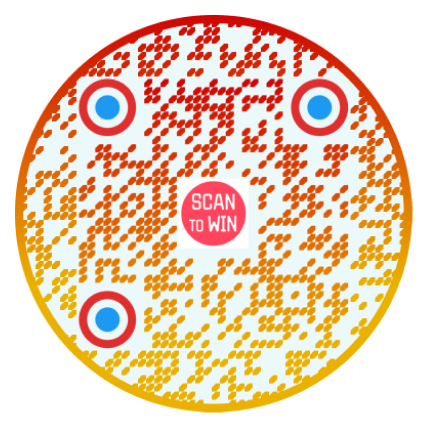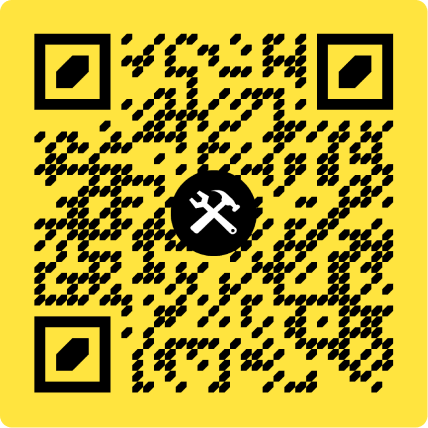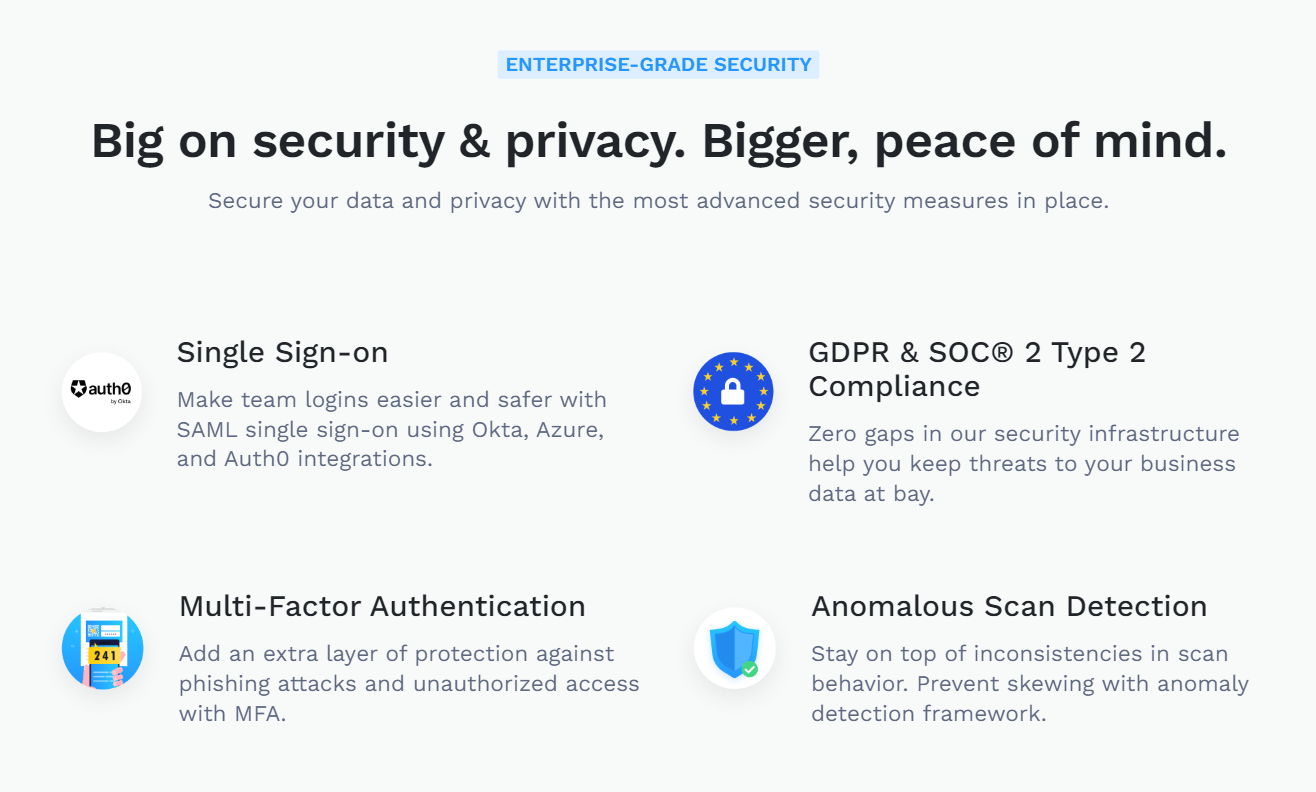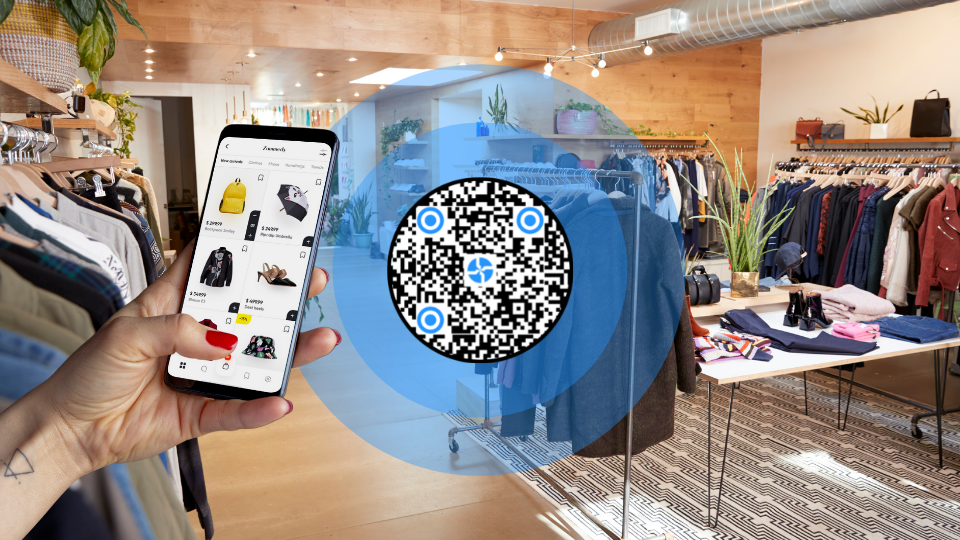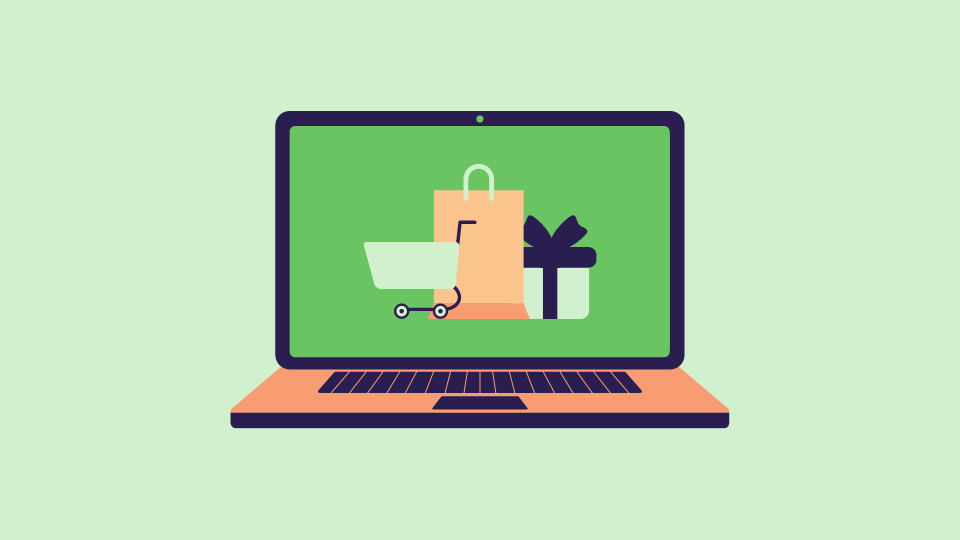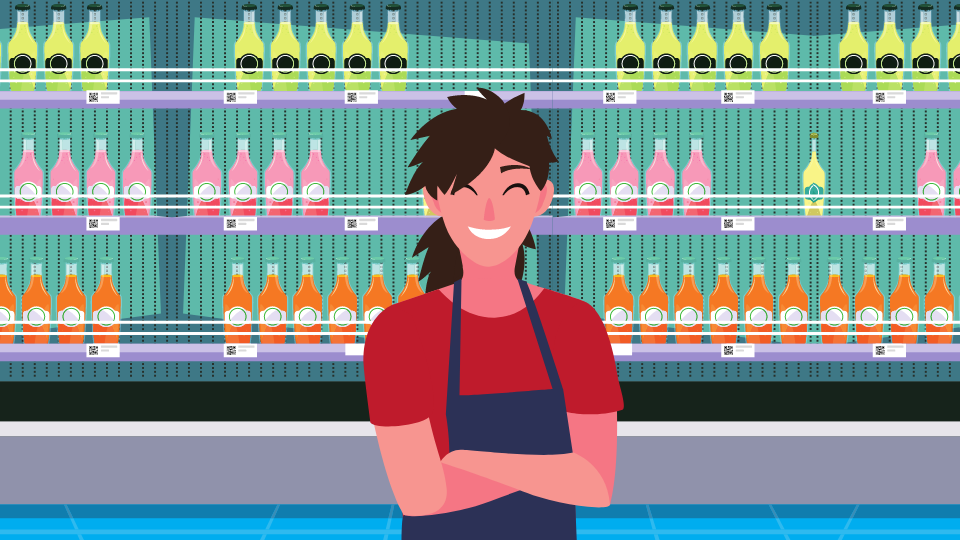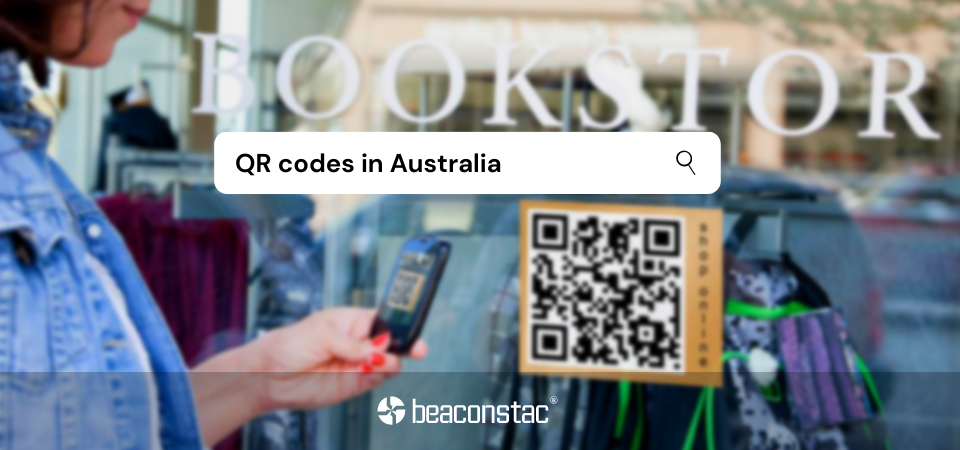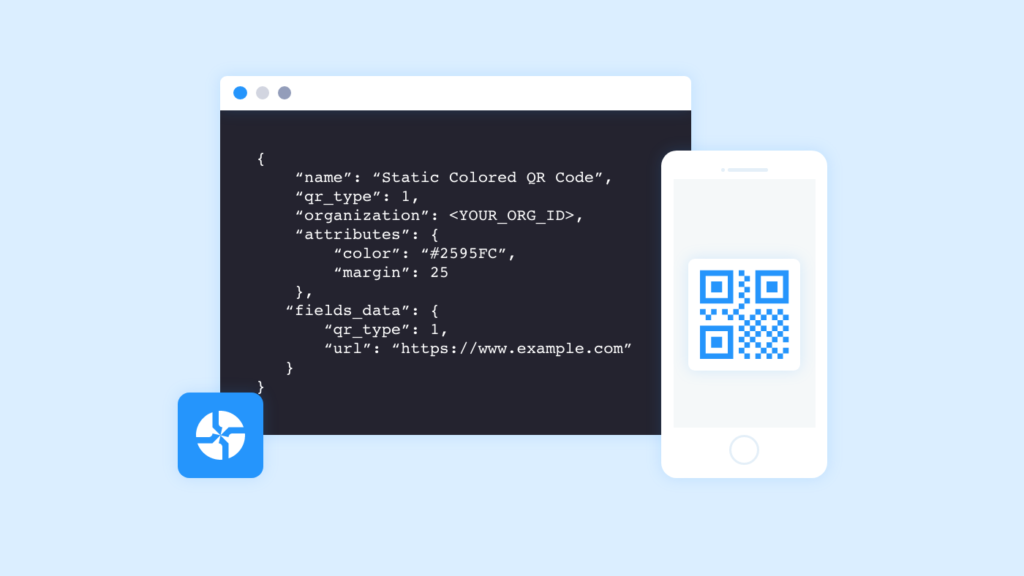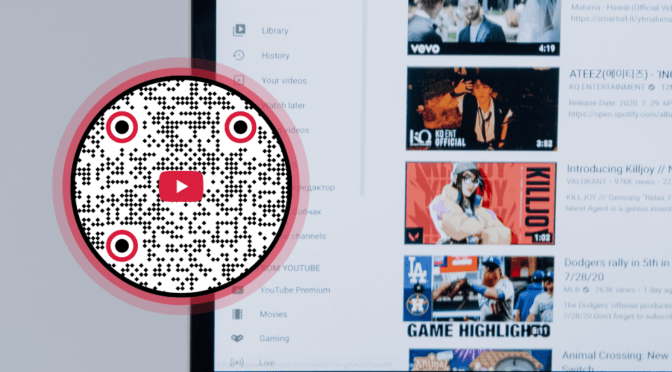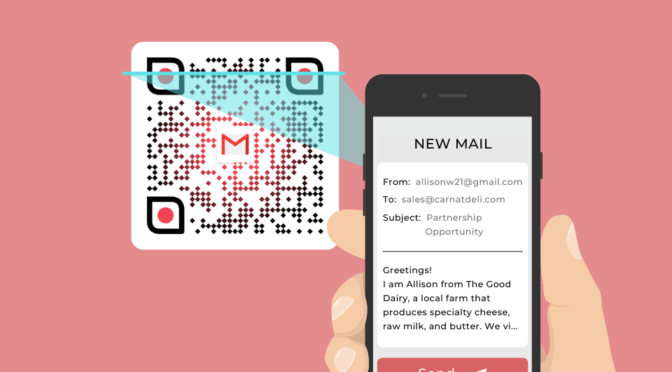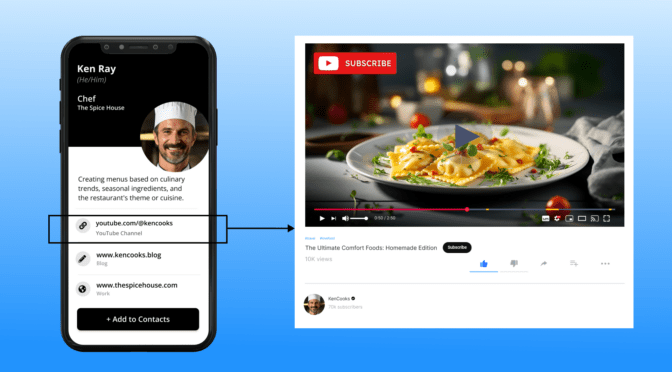Over 100 million people will be using QR Codes by 2025. As more and more people get used to seeing QR Codes everywhere, creating custom QR Codes to match your brand has become all the more necessary. This is because, for a QR Code to stand out, it must be more attractive, creative, and aligned with the brand’s identity. Here’s an example:
These are two different QR Code campaigns by a designer clothing brand. Which one are you more likely to scan and interact with?

If you chose B, you understand how important design is. But how do you break down the fundamentals of QR Code design and implement them? We sat with our expert designers for an exhaustive guide to designing a custom QR Code.
Table of Contents
- What is a Custom QR Code?
- 10 Best practices to make your QR Codes stand out: Pro tips
- How do you design QR Codes in 2 simple methods
- Places to use custom QR Code
- How to make my own personal QR Code?
- What are the benefits of custom QR Codes?
- FAQs
What is a Custom QR Code?
A custom QR Code is a unique branded appearance of a QR Code. With customization options such as colors, patterns (QR Code dots), backgrounds, logo, and CTA frame, you can design a unique QR Code representing your brand.
Because a custom QR Code gels organically with your brand’s design language, it attracts more scans than a plain black-and-white QR Code. You can easily create QR Codes that align with your brand and boost customer engagement using a custom QR Code generator such as Uniqode (👋that’s us!)
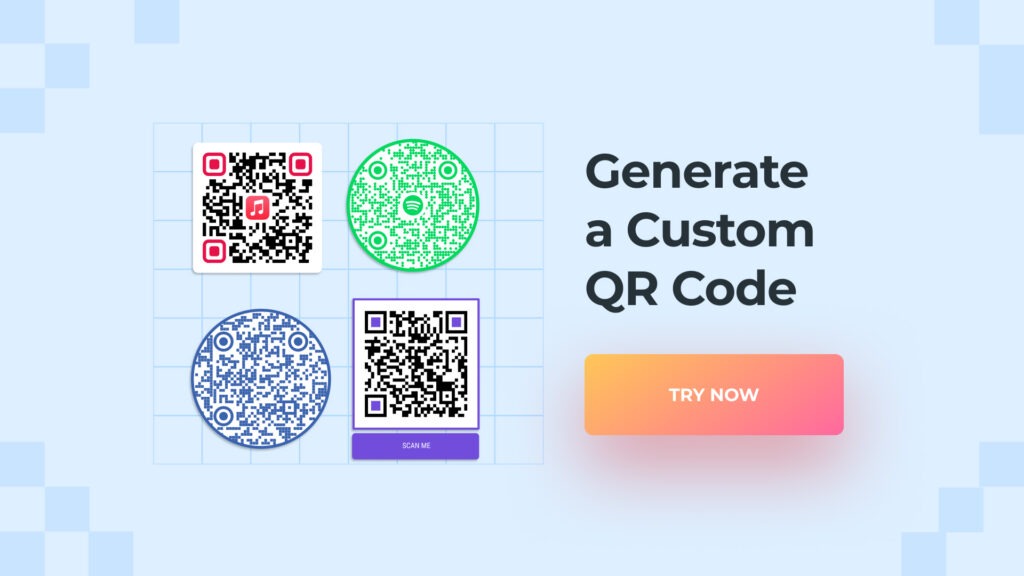
10 Best practices to make your QR Codes stand out: Pro tips!
We sat with the designers here at Uniqode and took their two cents on what it takes to design a personalized QR Code people will actually scan:
1. Strike the right balance between creativity and scannability
“Certain design choices come at the cost of the QR Code’s scannability,” Jehad Mohamed, lead product designer, says. For instance, to align a QR Code with your brand color, which could be a light shade of pink, you could end up creating a less scannable QR Code.
“This is because the scannability of QR Codes depends on the clarity of its pattern against the background,” Mohamed explains. His suggestion: “Try to have contrasting colors, eyes, and an uncluttered “quiet zone” around the QR Code.”
The quiet zone is the space around a QR Code and the adjoining elements where it’s being used.
However, this balance can be tricky to strike. It could be hard to guess whether a QR Code is scannable. And downloading it after every design tweak to test its scannability is cumbersome.
“This is where Uniqode’s scannability score feature comes in,” says Jehad. “You can see a live preview of the QR Code you designed and a score attributed to its scannability.”

A scannability score eliminates the guesswork, as you can try all the design ideas while knowing exactly if your changes are impacting the scannability of the QR Code.
2. Use Auto Design
Sometimes, all you need to do is create QR Codes that align with your brand colors. This is where Auto Design comes in. It’s an algorithm that analyzes your brand’s industry (from the information you upload) and gives suggestions based on constantly updated design trends.
“Auto Design is a proprietary feature on Uniqode’s QR Code maker that can intelligently analyze your brand logo and iterate multiple QR Codes based on the logo colors,” Jehad explains.
“If you do not like any of the auto-generated designs, you can continue to generate more options by clicking the ‘Refresh’ button.”
“If you like a generated design but do not agree with one of the aspects, for example, the eye color of the QR Code, you can edit that as these auto generations are fully editable,” explains Jehad.
Auto Design 2.0 goes a step further. It analyzes brand elements such as favicons, button colors, and more from campaigns such as your website URLs, restaurant menus, business page, etc., to suggest four custom-designed QR Code templates.
This feature eliminates a lot of manual customization from QR Code design, saving designers valuable time and resources and eliminating any learning curve for non-designers. A free QR code generator can also be used to create high-quality, customizable QR codes for commercial and print purposes, including options to add logos. If you already have a stunning brand logo, that’s good. Otherwise, you can easily design it using a free logo design tool.
3. Make the custom QR Code distinctive (rhombus, circle?)
Have a look at this QR Code design 👆. This QR Code by MTV, a cable channel, incorporated elements from their brand around the QR to make it stand out.
If your brand has elements like MTV’s, don’t hesitate to use them around the QR Code like this example suggests Jehad. “Just make sure that the ‘quiet zone’ or the space around the QR Code pattern is retained since it helps mobile devices decode it faster.”
“If you notice this example closely,” he further explains, “you will see the regular square QR Code is rotated to look like a rhombus! This custom liberty is unique to QR Codes because they’re scannable in any direction.”
If a circle QR Code fits better with your brand (cue: you sell donuts or pizzas), you can also do that on your QR Code generator if it supports QR Code shapes.
4. Try to create designs around the QR Code

While you can create QR Codes in different shapes, the square one tends to be the most easily recognizable. The ideal way is to create designs around the generated QR Code and give it distinct shapes.
Keeping the square QR Code intact in any design you create around it contributes to keeping the scannability high while allowing some scope for design workarounds.
Imagine how generic this black and white QR Code in the right image would look without the Mickey Mouse ears around it.
Similarly, the flame around the QR Code design on the right image gives it a distinct look while keeping the core square shape intact. All these QR Codes are highly scannable yet delightful to look at.
Creating QR codes can be fun and easy, allowing for customization to fit your brand.
5. Do not clutter the custom QR Code design
“Many of your QR Code design choices will also depend on the industry and overall positioning of your brand,” Vaidehie Chiplunkar, senior product designer at Uniqode, shares.
“For instance, if you’re in a multinational ecommerce company like Amazon, she explains, “a simple QR Code design with the logo in the center of a cardboard box works better than a flashy colorful design. This is because the brand value of the logo is enough to do the heavy lifting.”
Plus, such a QR Code is more universally appealing, easier to print in bulk, and complements the esthetic of a professional ecommerce service like Amazon.
If you operate in the same industry or brand identity as Amazon (hospitality, education, etc.), a simple QR Code with a logo can be all it takes for people to scan it, Vaidehie suggests. This way, you would prioritize scannability, scalability, and reliability more than design because that’s more important for you.
6. Get the color and contrast right
Colorizing QR Codes is ideal for creating the best QR Code designs and attracting a user’s attention. This, of course, does not imply that they can look appealing with any color combination.
Associate Manager of Visual Design, Aarti Lad shares three tips to follow before choosing the colors for a creative QR Code:
1. Color theme
When choosing the color theme for the QR Code, incorporate the brand’s color (using a hex editor available on Uniqode) so users can identify it.
“Use a 40% contrast (two colors at least 40% different) between the background and foreground colors that help the QR Code stand out,” Aarti explains.
2. Color scheme
While contrast is needed, “don’t use too many colors with different color schemes as this can render the QR Code unscannable,” says Aarti.
She suggests that a designer must “gauge the scannability of the code and incorporate the colors in it accordingly by testing the QR Code.” She also says that if the rest of the design is very vibrant (in the example below), a relatively monotone color of the QR Code could help.
If you use Uniqode, you don’t have to download a QR Code to test it. The scannability score gives you real-time updates as you design it.
3. Color gradient
Gradients can look amazing in the QR Code if done correctly and matched with the rest of the design.
However, Aarti explains, “Gradients can also make a QR Code less scannable if the contrast of the lighter end of a gradient (e.g., light gray) merges with a light background (e.g., white).”
“Experiment with different gradients and colors for the QR Code background to find the best scannability.”
7. Position the logo with the QR Code correctly
ou can play with different ways to position the logo in and around your QR Code. By default, most QR Code makers, including Uniqode, let you add a logo at the center of a QR Code. Nevertheless, you can also place it around the QR Code for more creativity.

“Place a logo in the center of the QR Code if you want to opt for a subtle and integrated customization option,” says Jehad. He further explains:
- Use a PNG logo so that it does not come with a background
- Try adding some space around the logo using the slider to make it clear and distinctive
- You can Increase or decrease the logo size using a slider on Uniqode’s custom QR Code generator

“If you want your brand’s logo to be more prominent, place the logo above the QR Code,” Jehad adds.
8. Modify the eye (shape and color)

You can customize the “eyes” of the QR Code to modify the entire look of the QR, our designers suggest in unison.
The color of the eyes can also be changed, but again, change the color according to the brand colors. “Place the eyes in a square-shaped frame for the best readability,” they suggest.
Ensure that the additional design changes you make do not cover the eyes of QR Code (or just use a QR Code generator where you can see the scannability score in real-time).
9. Customize the background of the QR Code

You can change the background of the QR Code to let the users know what the QR Code depicts. For instance, in the image above, the generated QR Codes are of a platform called Bring the Dog, which lists dog-friendly places in an area. Notice how the paws as the image’s background perfectly capture the brand’s logo and intent.
The background can either comprise an image or just a plain color.
“But, be sure that the background agrees with the color scheme of the QR Code. Most QR Code scanners cannot scan an inverted code (dark areas must stay dark, light areas must stay light. As a general rule, use a light background and a dark foreground),” warns Aarti.
She suggests that “it is best to keep the QR Code and background color schemes contrasting rather than merging them with similar colors, which would make the QR Code unscannable.”
“Also, while creating qr codes, if the background image contains patterns, emojis, or other elements, make sure that the opacity does not mess with the QR Code pattern to ensure better scannability.”
10. Add a CTA using a frame around the QR Code

Adding frames complementing the QR Code can amplify its visual look by multiple folds. A frame adds uniformity to the QR Code and makes it look distinctive.
Although you can place call-to-action messages in the center of the QR Code, placing them on the frame with colorful borders can help get more scans. “Frames also help keep the QR Code cleaner and distinct from the rest of the design around it,” says Vaidehie.
Related: Create compelling frame CTAs for your QR Codes with text below
How do you design a QR Code in 2 simple methods
If you’re ready to design highly scannable QR Codes, here’s how to create one. We’ll show two ways to customize your QR Code using Uniqode’s QR Code maker:
- Using Auto-Design
- Designing manually
Method 1: Using Auto-Design
Step 1: Log in to your Uniqode account, choose a campaign type to create a QR Code, and enter the details. E.g., if you choose the website, enter the URL
Step 2: In the “Customize” tab, click “Auto Design.” A pop-up will require you to add your logo. It will extract design elements (colors, logos, themes) from your data.
Step 3: Based on the analysis, Uniqode’s algorithm recommends a set of customized QR Code templates that appear before the pre-designed templates
Step 4: You can further customize the chosen design and adjust colors, patterns, logo placement, and more.
Detailed tutorial: How to use Auto Design to create custom QR Codes
Method 2: Designing manually
Here’s a quick guide on how to customize your QR Code manually:
Step 1: Log in to Uniqode dashboard
Step 2: Pick the type of QR Code
Step 3: Fill in the data: add a URL, image, etc., based on QR Code type
Step 4: Customize the QR Code by changing its eyes, template, color gradient, and adding a logo
Detailed tutorial: QR Code design: a complete how-to guide
Custom QR Codes use-cases: Where to use them
You can use a personalized QR Code everywhere and anywhere. Some of the use cases are:
1. As interactive billboards and banners
Calvin Klein’s 2010 “Uncensored” ad campaign is still a gold standard for a simple yet highly engaging QR-based ad, more than a decade later.
Instead of going the usual racy billboards way atypical to the brand, they chose a large QR Code comprising the entirety of a five-story-sized billboard in New York and Los Angeles. Users who scanned the QR Code were rewarded with an exclusive shareable video on social media.

The ad was notable because not many brands put a QR Code so prominently in an OOH then. Plus, the ad makers reportedly built proprietary software to scan and scan location-specific data for Calvin Klein to use in future marketing. Such data is now readily available on QR Code management platforms.
Per the ad’s makers, it performed “way, way more than anyone expected. The campaign has gone viral, and the hit rates are extremely high.”
🎒Your takeaway: When designing a QR Code for printing at a large scale in terms of dimensions, choosing the correct file format to retain its resolution after scaling up is essential.
-
File formats like SVG (scalable vector graphics)) and EPS (encapsulated postscript) let you play with the QR Code dimensions without losing quality
-
Use your custom domain from OOH ads to reinforce your branding and retain full control over the link
-
Install the QR Code in an OOH with a higher dwell time, such as near a traffic stop, bus stand, railway station, etc.
-
Maintain the ideal size of a QR Code on an OOH campaign: one-tenth of the scanning distance, which does not include the QR Code borders.
2. Touchless QR Code menus in restaurants

In 2020, governments worldwide mandated hotels and restaurants to provide a touchless dining experience using QR Code menus. The goal was to prevent contamination caused by using physical menu cards.
Marriott Aruba, a world-class resort chain, used our dynamic QR Codes to comply with the government restrictions on tangible items such as flyers, menus, and paper passes.
According to Noemi Trump, F&B and Social Marketing Executive, Marriott Aruba, “it is important that we’re able to match all of our marketing material with the standard of a premium resort. We needed to ensure that the QR Code solution we put our money into gave us the freedom to customize to our liking.”
Marriott’s team used Uniqode to create and deploy custom QR Codes for their resorts, each with a distinct theme. For instance, at each restaurant on the resort, they designed table stands with QR Codes aligned with the restaurant theme and cuisine.
Furthermore, they expanded to custom landing pages with their QR Codes to deliver gym schedules, book on-site COVID testing, show guests’ travel maps, and more. Marriott recorded 150,000 QR Code scans and 80,000 new customers in a year. They also brought their printing costs by $150,000.
“With Uniqode, we love that we’re able to turn away from so many paper flyers, booklets, and signages. We now have everything in one place—the Uniqode dashboard.”
– Noemi Trump, F&B and Social Marketing Executive, Marriott Aruba
🎒Your takeaway: If you’re a big chain such as Marriott with multiple restaurants, ensure the QR Codes are homogeneous. For instance, a bar can have QR Codes with golden accents, while a patisserie can have pastel-colored QR Codes with the same pattern and logo.
-
Use your QR Code generator’s dashboard to tag and categorize QR Code to attribute and track each of their performance
-
For a takeaway restaurant, use the custom QR Code adjacent to the price listing for easy scanning
-
Use a JPG or PNG file format to download the QR Code and export it to your design tool for smaller dimensions such as a menu block, tent card, etc.
3. Custom QR Codes in brochures, tent cards, and postcards

QR Codes on brochures are the ideal route to transform digital content into print media and reach out to customers. You can explore trifold brochure designs to redirect users to multiple digital destinations using different QR Codes in each fold.
For instance, in a restaurant, it helps to keep three different menus for food, drinks, and desserts. At a marriage event, there can be separate QR Codes for uploading and seeing wedding pictures, checking out the itinerary, and sending custom messages.

🎒Your takeaway: Decide the kind of QR Code to use based on the information it will contain and then customize it appropriately.
-
A brochure QR Code should be a minimum of 2×2 centimeters, so it is easily scannable
-
Avoid placing the QR Code on the edges to retain the readability of the QR Code
Read: How to incorporate colorful QR Code on brochures
4. Social media QR Codes

According to Statista, about 90% of US companies use social media for marketing. It implies that social media is a powerful marketing tool for all marketing campaigns.
You can use QR Codes from physical or digital touchpoints for your social media campaign to generate buzz around your upcoming releases, announcements, and more. Here’s a stunning example:
For her recent album, Taylor Swift placed life-size billboards with giant QR Codes worldwide as a part of her “The Tortured Poets Department” campaign. These custom QR Codes (made with the letter TTPD) redirected users to a cryptic YouTube short with a typewriter typing a lone letter. Different QR Codes around the world led to different shorts containing different letters!
Swifties realized that the letters, when synchronized, revealed the word “Fortnight,” which is the name of the first single in the album.
This and a series of surprise social media posts led to a consolidated campaign seamlessly merging the physical and the digital worlds. Read our analysis on how to do a QR Code campaign like Taylor Swift’s.
🎒Your takeaway: Strategize your Facebook, TikTok, Instagram, X (formerly Twitter), or YouTube campaigns from physical and digital platforms and create a QR Code to connect the two.
-
Maintain your brand identity by templatizing a custom QR Code and using it homogeneously
-
Track social media QR Codes performance based on the campaign goals such as unique scans, scan location, and demography—to optimize campaigns
5. Location-based QR Codes

If you need a system to help people navigate to your physical establishment, then location-based QR Codes could be a great way to simplify the process of:
-
Finding directions to a particular business or event
-
Highlighting a tourist attraction spot
-
Redirecting the user to the point of interest or creating landmarks
Several municipalities in India are using location-based QR Codes to provide vital information to their citizens. For instance, India’s IT capital, Bengaluru, uses location-based QR Codes in bus stands, metro stations, and parks to help people in distress navigate to the nearby police station.
Coffee giant Starbucks launched an ad campaign across the US using location-based QR Codes from flyers, newspapers, billboards, and standees. Users had to scan a QR with the Starbucks mobile app to navigate to the nearest cafe, watch exclusive videos, check product offers, and browse the menu.
🎒Your takeaway: Enter your location coordinates on a map and use the same link to generate a location-based QR Code. Upon scanning, users can navigate to the location via a map app on their mobile device.
-
You can place a location-based QR Code anywhere: brochures, texts, social media pages, billboards, flyers, receipts, etc
-
Make sure to include “Maps” as the logo and a “Scan to navigate” CTA on the QR Code so users know that it is a location-based QR Code
6. QR Codes on custom materials
You can create a custom QR Code and emboss/print it on any material you choose.
From vinyl decal store windows to metal and wooden engravings, custom QR Codes on these materials further help bridge the gap between the digital and physical world by making them more tangible. They also provide a more premium experience than a paper QR Code.
🎒Your takeaway: Make sure to create only dynamic QR Codes for embossing on wood, metal, and glass materials. You should be able to change the QR Code content without re-embossing one. A dynamic QR code generator can further create editable and trackable QR codes, which are beneficial for long-term campaigns and analytics.
-
Keep the QR Code as simple as possible, even avoiding adding a logo for embossing, to help get a cleaner emboss on materials. You can always add brand elements around the QR Code
-
If you use Uniqode’s QR Code generator, maintain a ‘GOOD” scannability score and test the QR Code before embossing with multiple devices using the live preview while generating it
-
Use a higher error-correction level on your QR Code maker’s dashboard to ensure they’re scannable with some degree of damage
10. Personalized QR Codes for vCards

vCards or e-business cards contain contact details such as name, address, email, URLs, or any other relevant information to the business.
You can use custom QR Codes from a physical or digital touchpoint and redirect users to your vCard containing information about your businesses/brands.
Physical touch points include paper cards, postcards, and handouts. Digital touch points include video call backgrounds, LinkedIn, and email signatures.
🎒Your takeaway: Here’s a guide on how to design and use vCard QR Codes
What are the benefits of a QR Code with custom design?

1. Brand recognition
Custom QR Codes with logos and appropriate color palettes can help customers recognize any brand efficiently without any difficulty.
Syncing colors and brand logos improves brand recognition by up to 80%, revealing the importance of ensuring all the elements of your design match your brand.
2. Omnichannel analytics
Using customizable QR Codes across platforms ranging from social media to offline marketing materials makes it easy to analyze and interpret the overall QR Code campaign data across each platform.
Some QR Code generators, such as Uniqode, integrate with Google Analytics and can drive demographic data, such as age, gender, etc., of the people who scan your QR Codes. The combined location data can help create targeted campaigns where you’ll most likely get users.
You can also quantify the ROI on your design efforts by A/B testing custom and non-custom QR Codes on marketing campaigns to monitor which campaign performs best and utilize the best-performing QR Code on the campaign.
3. Save on advertising cost
Traditional advertising using tangible materials such as paper is costly, especially if the information must change frequently. Plus, you cannot reuse one marketing material in multiple channels. That’s not the case with custom QR Codes.
If you use dynamic QR Codes, you cut the costs associated with printing materials and the ones needed to reprint a new one to redirect to a new destination. One QR Code can distribute any piece of information to thousands. Plus, simply changing the URL in the backend will update the content.
For instance, once created for, say, a brochure to redirect to your website, you can use the same QR Code on standees, tent cards, and other places.
Maesa, a CBD products company, saved $10,000,000 in potential compliance-lapse penalties associated with their packaging using dynamic QR Codes.

5. Lifetime validity with unlimited edits and redirects
Custom QR Codes, once created, will keep redirecting your target audience to intended digital destinations.
Even if the URL gets an error for some reason or the QR Code destination must change, you can do that anytime, even after printing. All this is typically available for a small subscription free.
Your QR Code will only stop working when your subscription expires. If you use a static QR Code, it’s also valid for a lifetime. It will only expire when the link is damaged or you must change the destination.
Why create custom QR Codes now?
According to Uniqode data, QR Code creation increased 247% by mid-2023 compared to 2021. The cue is simple: With so many QR Codes everywhere, getting people to scan a black-and-white QR Code could get challenging.
If you’re using QR Codes for bottom-line defining campaigns, such as Marriott, Starbucks, Calvin Klien, and many others, it’s best to treat them as part of your brand, which is where custom QR Codes come in.
Invest in QR Code platforms that provide customization options while simplifying the design process so that non-designers can create them, too.
Have a specific design use case that you want to learn more about? Talk to us.
Frequently Asked Questions
1. How can I create a custom QR Code?
To create a custom QR Code –
- Choose a free online QR Code generator
- Pick a type of QR Code and fill in the details
- Customize the QR Code by adding a logo, changing color patterns, and even a CTA
- Generate and test the QR Code
- Download the QR Code
2. How do I turn a picture into a QR Code?
To turn a picture into a QR Code –
- Choose an online QR Code generator
- Pick Image QR Code on the dashboard
- Upload an image from your gallery
- Customize the QR Code by adding a logo, changing color patterns, and even a CTA
- Generate and test the QR Code
- Download the QR Code
3. How to make a custom QR Code with a logo?
To create a custom QR Code with a logo –
- Choose an online QR Code generator
- Pick a type of QR Code and fill in the details.
- Customize the QR Code by adding a logo
- Generate and test the QR Code
- Download the QR Code
4. Can I create my own QR Code?
Yes, you can. To make your own QR Code –
- Choose a free online QR Code generator
- Pick a type of QR Code and fill in the details
- Customize the QR Code design by adding a logo, changing color patterns, background, and even eyes
- Generate and test the QR Code
- Download the QR Code
5. Can I make my own QR Code for free?
Yes. Follow these simple step to make your own QR Code for free.
- Choose a free online QR Code generator
- Pick a type of static QR Code and fill in the details
- Customize the QR Code by adding a logo, changing color patterns, background, and even eyes.
- Generate and test the QR Code
- Download the QR Code
6. Can a QR Code be of any shape?
A QR Code can be of any shape, but make sure the eyes are not misaligned, else the QR Code will be deemed unscannable. Keep in mind that extreme digression from a QR Code’s shape will make it unrecognizable and unscannable for QR Code scanners.
7. Do QR Codes expire?
A static QR Code does not expire, as long as the URL linked to the static QR Code is still functioning. Else, the QR Code will not work, meaning that it will not redirect the user to a working website.
A dynamic QR Code works as long as the subscription plan is active. Post the deactivation, the QR Code will stop working.
8. Can I make a QR Code circular?
Yes, you can create a QR Code the regular way and make it circular through the templates available on the QR Code platform. Essentially the square QR Code has some extra design bits all around it to make it a circular QR Code.
9. Can a QR Code be any color?
Absolutely. You can change your QR Code’s color scheme to match your brand, capture your audience’s attention, and improve brand recall. Colorful QR Codes help with garnering higher scan rates and enhance customer engagement.
-
With brands expanding their presence on omnichannel platforms to reach more audiences, learn how QR Codes help brands sync their online and offline marketing strategies to close the loop seamlessly.
-
Trying to build a loyalty program for your brand? Look no further! Check out this complete guide on the best customer loyalty platforms to help pick the best one and foster long-term brand loyalty effectively.
-
Struggling to improve in-store sales and shelf performance rate for your brick and mortar retail store? QR Codes for planograms are the answer you’re looking for.
-
Looking for a design software that fits your requirements? Check out this detailed guide on product packaging design tools with helpful information on how to create an effective packaging design.
-
What led to the surge in the usage of QR Codes in Australia? Is it because of contact tracing or payments? What does the future hold? Let’s find out.
-
Want to know how to add a QR Code API to your app without complex troubleshooting? Read to find out!







